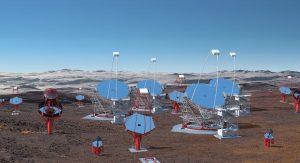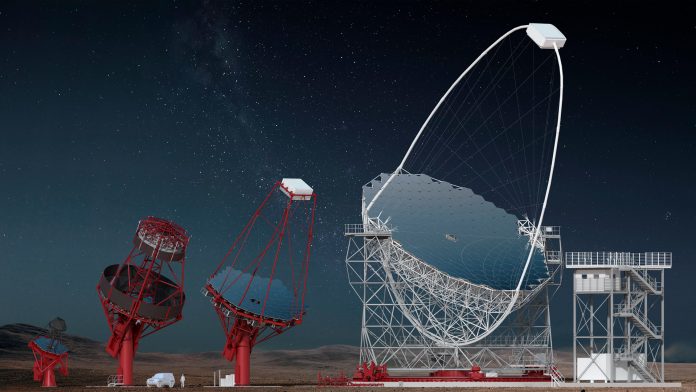CTAO Project Scientist, Dr Roberta Zanin, spoke to The Innovation Platform about the Cherenkov Telescope Array’s role in areas such as dark matter detection, gravitational wave observation, and multi-messenger astronomy.
Once operational, the Cherenkov Telescope Array (CTA) will be ten times more sensitive than current-generation ground-based gamma-ray detectors. It will also have unprecedented accuracy in its detection of high-energy gamma rays, while its use of more than 100 telescopes located in the northern and southern hemispheres will enable it to detect gamma rays over a larger area and a wider range of views than with current gamma-ray telescopes.
Together, the northern and southern CTA arrays will constitute the CTA Observatory (CTAO), which will be the first ground-based gamma-ray observatory open to the worldwide astronomical and particle physics communities as a resource for data from unique, high-energy astronomical observations.
CTAO’s Project Scientist, Dr Roberta Zanin, spoke to The Innovation Platform about CTA’s role in areas such as dark matter detection, gravitational wave observation, and multi-messenger astronomy.
What is the current status of the CTA? Are you still on course to begin operations in 2022? Has the current COVID-19 pandemic held things up?
The CTA Observatory (CTAO) will enter the construction phase hopefully next year when the final, legal, CTAO European Research Infrastructure Consortium (ERIC) will be established. The current COVID-19 pandemic has delayed this milestone by a few months.
The construction phase is envisaged to last for about five years. Regular operations will, therefore, not start before 2026.
The follow-up observations of gravitational wave (GW) events have been assigned the highest priority in CTA’s key science project on transient phenomena. What will this involve?
The GW follow-up programme envisaged for CTA consists of two main steps:
- Follow-up observation scheduling: once it has received the gravitational wave (GW) alert and its localisation, the CTA transient handler system will optimise the pointing strategy to cover the most probable sky regions as fast as possible. There are different algorithms foreseen for the computation needed to compute the probability of a region to host a GW event within the area covered by the localisation uncertainty. One of them is related to the usage of distribution of galaxies, interpreted as plausible hosts of these cataclysmic events; and
- The real-time analysis (RTA) of acquired data: each observation is analysed in real time by the RTA pipeline, which is able to detect minute emissions and eventually trigger deeper observations on the region to assess the detection of the potential electromagnetic counterpart. Different timescales can be explored for the signal detection. Once the detection is established, CTA will issue a science alert to external observatories at low latency, below 30 seconds.
What will the key benefits of the CTA be when it comes to searches for multi-messenger counterparts to astrophysical neutrinos and gravitational wave events?
The major ingredients that make CTA a key partner instrument in the search for electromagnetic counterparts to astrophysical neutrinos and gravitational wave events are:
- Unprecedented sensitivity to short (sub-minute) timescale phenomena;
- Several degrees gamma-ray field of view;
- Online source localisation is at arcmin level;
- Capable of issuing science alerts to external observatories within 30 seconds from the internal detection;
- Repointing within one minute from the alert notification (the LSTs can be repointed within 40 seconds); and
- Almost all sky coverage thanks to two sites.
CTA will be able to respond to the incoming neutrino/GW alert within one minute, improve the localisation of the event down to a sub-arcminute precision, and redistribute the information to the partner facilities on minute timescales.

© Gabriel Pérez Diaz, IAC/Marc-André Besel, CTAO
What are the science goals in terms of the search for dark matter, and what do you hope will come from the planned survey of the Galactic Centre?
One of the main science goals of CTA is to shed light on the nature of dark matter. While it is almost certain that dark matter exists – and, indeed, in far higher quantities than normal matter, given its measured gravitational effects – almost nothing is known about what it actually is.
Long-standing dark matter candidates are the weakly interacting massive particles (WIMPs), with a mass of 100-1,000 times the mass of a proton (100 GeV-1 TeV, approximately).
WIMPs can be discovered via their production in particle collisions detectors (like in the Large Hadron Collider (LHC) at CERN in Geneva), but also through astrophysical observations. The main idea of the latter is that in regions of the Universe where dark matter density is high, dark matter particles could self-annihilate or decay, producing more familiar particles that would reach us in the form of cosmic rays, as well as gamma rays.
Thus, CTA will use its unprecedented sensitivity and energy resolution to capture gamma rays exactly over the energy range that corresponds to the heavier end of the WIMP masses, which remains largely unexplored.
The Galactic Center is certainly one of the best sky regions to look for DM signatures, since it is expected to host a high density of dark matter. In particular, the planned deep survey of the Galactic Center will enable CTA to reach the expected thermal relic cross-section for self-annihilating WIMPs, thus exploring the ‘Holy Grail’ region of the WIMP scenario in detail for the first time in an unrivaled way.
Beyond WIMPs, CTA will also play a major role in exploring the currently inaccessible axion-like particles, i.e. another theoretically well-motivated DM candidate. Once more CTA will use its unprecedented sensitivity and energy resolution to probe possible enhancements of the TeV photon flux from very distant extragalactic sources, i.e. Active Galactic Nuclei or Gamma Ray Bursts. Competing with the gamma ray absorption on the lower energy Extragalactic Background Light (EBL) photons, such a flux enhancement could provide a smoking-gun signature of photons/axion-like particles coupling along their long journey, under the influence of intergalactic magnetic fields.
What does the recent detection of the Crab Pulsar mean for the LST-1? Why is this significant, and how does it lend hope for the future?
The recent detection of the Crab Pulsar by the LST prototype is an important milestone for the CTA construction project showing that this telescope, although still in its commissioning phase, is already performing well from a scientific point of view, detecting a challenging source in record time.
Technically, this result verifies the timestamping system and represents a first important step towards the validation of the low-energy performance of the LST.
Pulsars have recently been promoted to key scientific targets for CTA after their establishment as a new class of VHE gamma-ray emitters, at odds with any existing theoretical understanding of gamma-ray pulsars. The discovery of pulsations up to TeV energies opened a new window in pulsar physics, whose deep exploration can be reached for CTA thanks its unprecedented sensitivity, especially in the low-energy range covered by the LSTs. In that respect, the detection of the Crab pulsar by the LST-1 paves the way for high-impact discoveries in the pulsar field by CTA.
What is the next step for the CTA?
The next step is now to get CTA up and running. We are also planning to validate its scientific performance at incremental stages, thus already producing good quality science data during the construction phase. This will allow for the exploitation of the new discovery space of CTA since the very beginning, that, especially in the Northern site where we plan to build the other three LSTs in the coming three years, will impact the field of the time domain astronomy.
Dr Roberta Zanin
Project Scientist
Cherenkov Telescope Array
Observatory (CTAO)
roberta.zanin@cta-observatory.org
Tweet @CTA_Observatory
www.cta-observatory.org
Please note, this article will also appear in the third edition of our new quarterly publication.







